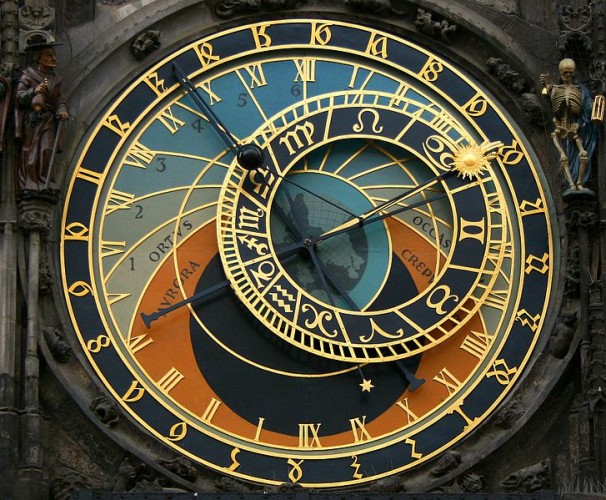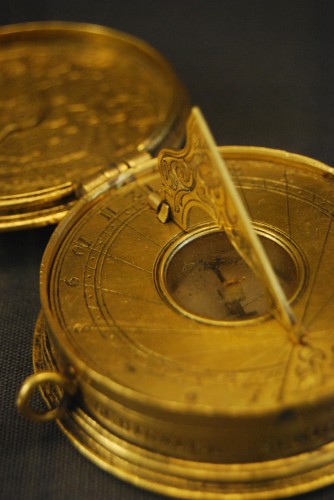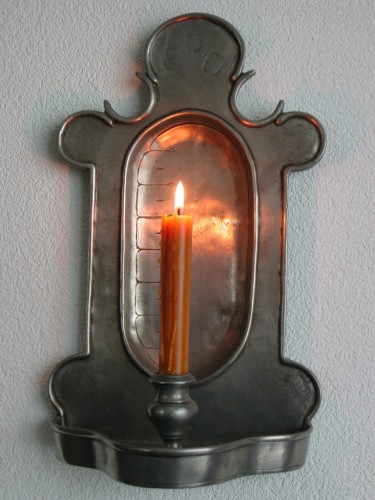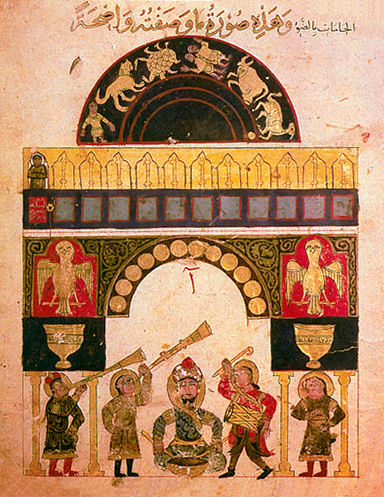Traveling within the World
Linking your favorite traveling artists across the globe
Tempus Fugit By Danièle Cybulskie
By Danièle Cybulskie
Because it seemed to get away from me last week, I’ve decided to write this week’s blog on time.
Like most things, the measurement of time followed the lead of the church. The day was divided into many intervals in order for the devout to ensure they were praying round the clock. These times for prayer not only included daytime, but also night. Since it’s particularly helpful, I’m lifting this note straight out of Umberto Eco’s The Name of the Rose to give you a sense of how the day was divided (the bold font is mine, to accommodate formatting issues):
Matins – Between 2:30 and 3:00 in the morning.
Lauds – Between 5:00 and 6:00 in the morning, in order to end at dawn.
Prime - Around 7:30, shortly before daybreak.
Terce - Around 9:00.
Sext - Noon (in a monastery where the monks did not work in the fields, it was also the hour of the midday meal in winter).
Nones - Between 2:00 and 3:00 in the afternoon.
Vespers - Around 4:30, at sunset (the Rule prescribes eating supper before dark).
Compline - Around 6:00 (before 7:00, the monks go to bed).
Eco’s times reflect winter in northern Italy (and follow the Benedictine Rule), but this should give you a good idea of how many times monks and nuns were called to pray, and how many times their bells would ring out throughout the day and night.
If you needed to know the time between bells, there were several ways to find out.
Hourglasses
Although I’ve put it first, because it seems to be the most obvious, this was actually a later invention than the other clocks. Here is a picture (said to be the earliest) from the 14th Century:
Sundials
Another seemingly obvious addition, but sundials were not just the fixed, garden items we imagine today. In fact, sundials were some of the earliest portable timekeepers – watches, if you will. Here is an image of a pocket sundial.
And here are a few other designs. (Apparently, you can buy them online, if they strike your fancy.)
Candles
Because the burning of a candle is a fairly predictable thing, people could measure time by marking candles by the hour. When a candle had burned down to a certain mark, that many hours had passed. Here is a picture of a timekeeping candle:
Water Clocks
Water clocks work by the flow of water moving from one container into another. Beyond this potentially working a bit like an hourglass, water was also used for its ability to move mechanisms.
Mechanical Clocks
Here’s where I profess my ignorance. Mechanical clocks started to appear around the 13th Century, but their workings are a little mysterious. Were they water clocks? Were they wound? These questions are beyond my knowledge. Nevertheless, here is a 14th-Century illustration of what appears to be a mechanical clock from St. Albans Abbey:
With all these options, here’s hoping I will be able to keep time as well as medieval people in future.
You can follow Danièle Cybulskie on Twitter @5MinMedievalist
Tags:
Replies to This Discussion
Events
-
2014 is the Chinese Year of the Horse
February 17, 2026 at 12am to February 5, 2027 at 12am – where & how you choose
Birthdays
Important (read & understand)
Skype: Travelingraggyman
Email and Instant Messenger:
TravelerinBDFSM @ aol/aim; hotmail; identi.ca; live & yahoo
OR
Travelingraggyman @ gmail and icq ***

1AWARD UPDATES & INFORMATION
10,000 votes - Platinum Award
5,000 votes - Gold Award
2,500 votes - Silver Award
1,000 votes - Bronze Award
300 votes - Pewter Award
100 votes - Copper Award
Member of the Associated Posting System {APS}
This allows members on various sites to share information between sites and by providing a by line with the original source it credits the author with the creation.
Legal Disclaimer
***************We here at Traveling within the World are not responsible for anything posted by individual members. While the actions of one member do not reflect the intentions of the entire social network or the Network Creator, we do ask that you use good judgment when posting. If something is considered to be inappropriate it will be removed
Site Meter
This site is strictly an artist operational fan publication, no copyright infringement intended
Patchwork Merchant Mercenaries had its humble beginnings as an idea of a few artisans and craftsmen who enjoy performing with live steel fighting. As well as a patchwork quilt tent canvas. Most had prior military experience hence the name.
Patchwork Merchant Mercenaries.
Vendertainers that brought many things to a show and are know for helping out where ever they can.
As well as being a place where the older hand made items could be found made by them and enjoyed by all.
We expanded over the years to become well known at what we do. Now we represent over 100 artisans and craftsman that are well known in their venues and some just starting out. Some of their works have been premiered in TV, stage and movies on a regular basis.
Specializing in Medieval, Goth , Stage Film, BDFSM and Practitioner.
Patchwork Merchant Mercenaries a Dept of, Ask For IT was started by artists and former military veterans, and sword fighters, representing over 100 artisans, one who made his living traveling from fair to festival vending medieval wares. The majority of his customers are re-enactors, SCAdians and the like, looking to build their kit with period clothing, feast gear, adornments, etc.
Likewise, it is typical for these history-lovers to peruse the tent (aka mobile store front) and, upon finding something that pleases the eye, ask "Is this period?"
A deceitful query!! This is not a yes or no question. One must have a damn good understanding of European history (at least) from the fall of Rome to the mid-1600's to properly answer. Taking into account, also, the culture in which the querent is dressed is vitally important. You see, though it may be well within medieval period, it would be strange to see a Viking wearing a Caftan...or is it?
After a festival's time of answering weighty questions such as these, I'd sleep like a log! Only a mad man could possibly remember the place and time for each piece of kitchen ware, weaponry, cloth, and chain within a span of 1,000 years!! Surely there must be an easier way, a place where he could post all this knowledge...
Traveling Within The World is meant to be such a place. A place for all of these artists to keep in touch and directly interact with their fellow geeks and re-enactment hobbyists, their clientele.
© 2025 Created by Rev. Allen M. Drago ~ Traveler.
Powered by
![]()





